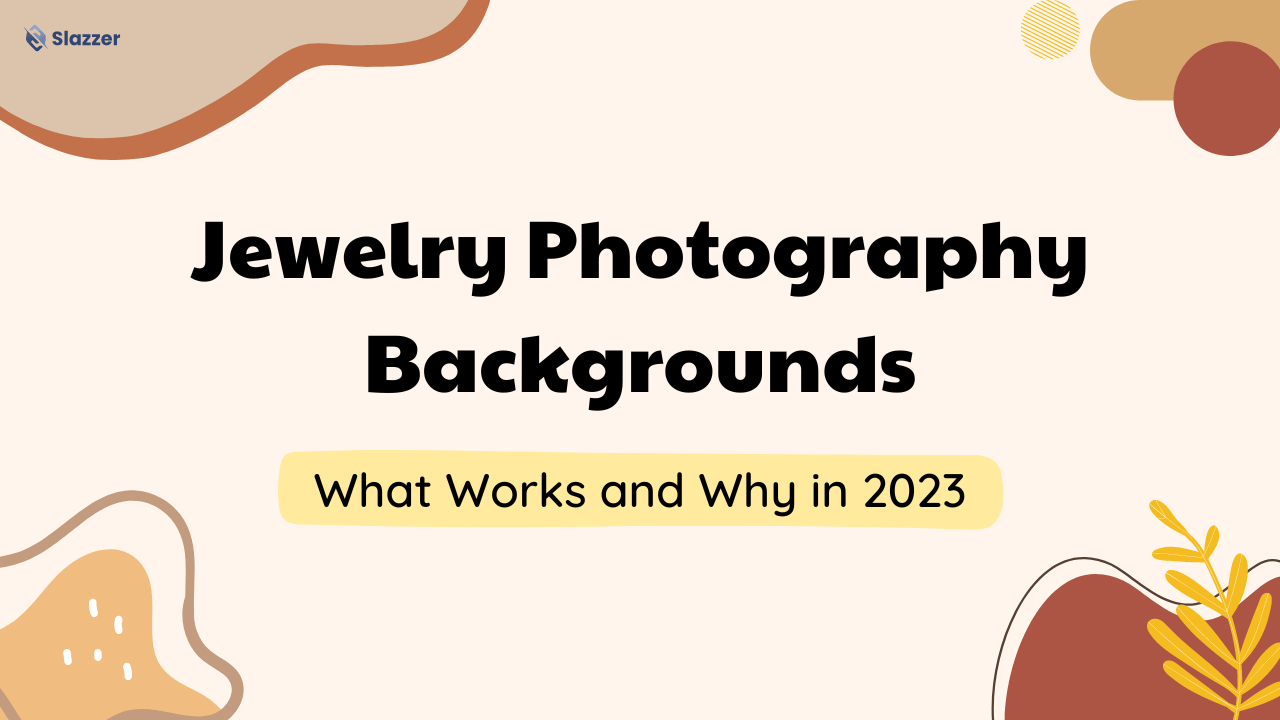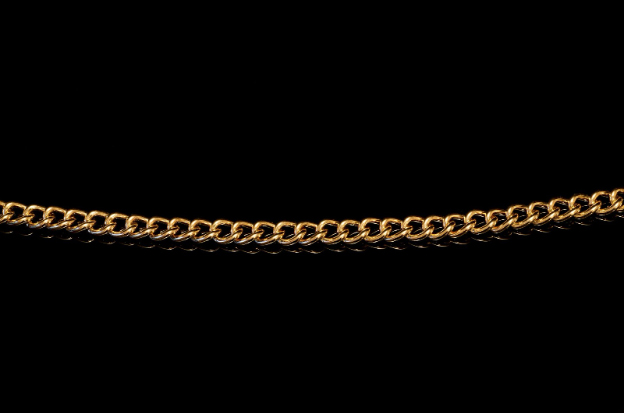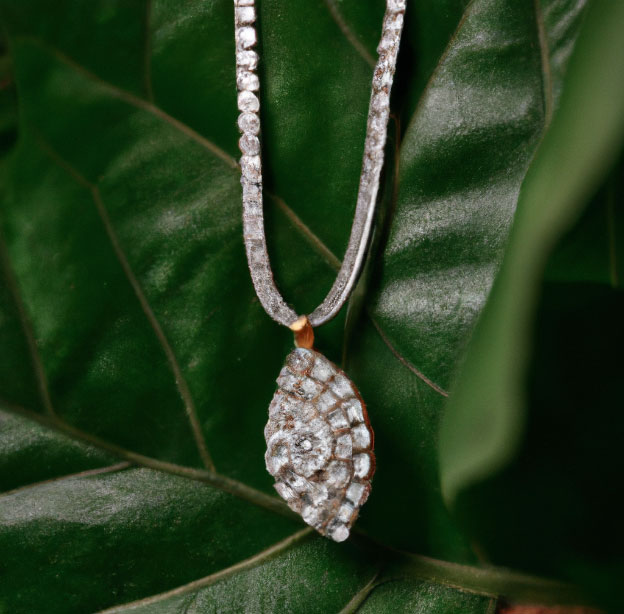- Tips & Tricks
- Sep 14, 2023
Jewelry Photography Backgrounds: What Works and Why in 2023

So you’ve invested in some gorgeous jewelry that you want to photograph for your online store or just to show off on social media.
Great choice! Now you need to think about the best way to make those gemstones and metals really sparkle on camera. The background you choose can make or break your jewelry photos.
As an amateur photographer, I’ve experimented with all kinds of backdrops and lighting to find what works for capturing the true beauty of necklaces, rings, bracelets, and more.
In this article, I’ll share some of my favorite simple DIY backgrounds for jewelry photography that you can create at home, why they work so well, and tips for styling your photos to make the most of these backdrops.
Let’s Dive in!
Introduction: The Importance of Choosing the Right Background
Choosing the right background for photographing jewelry is key to capturing stunning images that do your pieces justice.
The background sets the overall tone and vibe of the photo. It can enhance the beauty of the jewelry or distract from it.
Keep it Simple
A simple, minimalist background is usually your best bet for jewelry photography. Busy, cluttered backgrounds compete for attention and make your subject get lost in the chaos. Plain white, black, and gray backdrops are versatile, neutral options that keep the focus on the jewelry.
For a clean white background, use poster board, foam board, or seamless paper. These provide an evenly lit surface without texture. A lightbox is ideal for product photography and allows you to control the lighting. If you want to get more creative, pale pastel backdrops in pink, blue or mint also work well for a minimal, colorful effect.
1. Simple Solid Colored Backgrounds for Classic Looks
Simple solid colored backgrounds are perfect when you want the focus to be on your jewelry. They provide a clean backdrop that highlights the details and contours of each piece.
White

White is a classic choice for jewelry photography. It makes pieces pop and captures their true color. However, too much white can seem stark and wash out warmer metal tones like rose or yellow gold.
For the most flattering results, choose an off-white or eggshell shade.
- Off-white fabric or seamless paper works well and is inexpensive.
- Make sure the background is evenly lit to avoid shadows. Soft box lighting is ideal.
Black

Black backgrounds create dramatic, high-contrast photos that emphasize the shape and texture of jewelry. Darker stones and metals tend to get lost against solid black, though. In those cases, try a dark gray or charcoal backdrop instead.
- Velvet, felt and suede are luxurious black backdrop options.
- Increase lighting and consider using supplementary flashes or spotlights to properly illuminate your subject against the dark background.
Other options
Mid-tone grays, navy blues, hunter-greens, and burgundies also make stunning yet versatile backdrops for most jewelry types and metal colors.
And don’t be afraid to get creative — a distressed wood board, colorful fabric, or textured wallpaper can all make unique jewelry photography backgrounds.
In the end, keep your individual jewelry pieces and brand Aesthetic in mind.
2. Textured Backgrounds Add Visual Interest
Textured backgrounds are a great way to make your jewelry photos pop and capture the viewer’s attention.
Unlike a plain white backdrop, textured surfaces add visual interest that complements the shapes and details of your pieces. They provide a contrast that helps the jewelry stand out.
Natural Textures Are Eye-Catching

Natural textures like wood, stone, sand, and foliage make an organic, earthy background for bohemian or nature-inspired jewelry. A rough plank of weathered wood or a stone surface can showcase the natural materials in your pieces.
For a beachy vibe, try fine-grained sand or sea shells. Delicate jewelry also pairs well with greenery like eucalyptus leaves or lavender sprigs.
Get Creative with Household Items
Don’t overlook common household items as unique textured backgrounds.
A weathered wooden door, brick wall, woven basket, or corkboard is simple to style and provides rustic charm. Get playful by arranging colorful enamel pins, clothespins, colored pencils, or crayons.
A wicker bowl or wire basket makes an airy base for delicate pieces. Vintage books, maps, or sheet music stacked in a pile impart a stylish editorial quality.
With some experimentation, you’ll find the perfect textured surface to showcase your jewelry and set the mood you want to convey.
Keep your photos cohesive by choosing a consistent color palette and style for your backgrounds. And have fun with it — unusual or whimsical settings that match your brand’s personality will make your product photos unforgettable.
3. Using Fabric for a Soft, Elegant Feel
Using fabrics as backdrops for jewelry photography can create a soft, elegant feel for your photos. Velvet, felt, satin, and linen are all great options to try. Their matte, textured surfaces help capture the little details in jewelry and create subtle highlights.
Velvet

Velvet is a plush, luxurious fabric that gives jewelry a high-end, glamorous look. Its pile creates a soft depth of field that helps jewelry stand out.
Velvet also absorbs extra light, reducing glare on shiny pieces. For extra drama, choose a vibrant color like red, royal blue, or emerald green. Black is always a classic, elegant choice.
Felt
Felt is a thick, durable fabric with a fuzzy, matted surface. It’s available in a range of neutral and pastel colors that provide a muted, earthy backdrop for jewelry.
Felt absorbs light, giving your photos a soft, diffused quality. It’s a great option if you want to create a bohemian or rustic vibe. Gray felt in particular helps shiny silver or pewter jewelry pop.
Satin
Satin has a lustrous, silky surface that elegantly highlights the contours and details of jewelry. Its subtle sheen creates bright highlights on curved and textured surfaces.
Satin also has a luxurious drape that can be artfully arranged in your photos. For a bold look, try jewel-toned satin in ruby, sapphire, or amethyst.
Linen

Linen has an uneven, textured weave with random slubs and knots that add visual interest.
Its casual, laid-back feel pairs well with bohemian or artisanal-style jewelry. Linen produces a diffused, natural-looking light that flatters gold and gemstone jewelry.
White or off-white linen is a perfect neutral backdrop, while colored or patterned linen can create an eclectic vibe.
Experiment with different fabrics and arrange them in loose folds and drapes for added visual drama. The perfect fabric and arrangement can take your product photos to the next level.
4. Wood and Marble for Natural, Organic Vibes
Wood and marble backgrounds are classic, natural choices for jewelry photography. They provide an organic, earthy vibe that pairs beautifully with gemstones and metals.
Wood

Wood, such as pine, oak or teak, makes an ideal rustic background for jewelry photos. The natural grains and knots in the wood add visual interest. Wood backgrounds work especially well for bohemian or nature-inspired jewelry styles.
Some tips for using wood:
- Choose a piece of wood with an interesting pattern of grains for the most visual appeal. Smooth planks of wood also work great if you want a simple, clean look.
- Distress the wood by sanding, scraping, or staining to give it a rustic, weathered appearance. This helps the jewelry stand out more.
- Pair lighter-colored wood, such as pine or oak, with gold jewelry. Darker wood like teak complements silver jewelry.
- Wood photography backgrounds are easy to make yourself. You can find wood planks at your local hardware store, then sand, stain and seal them. Or use reclaimed wood from old furniture or buildings for an authentic aged look.
- The natural texture of wood helps to diffuse the light, softening harsh shadows. You may need to adjust your lighting to compensate, using diffused light sources at multiple angles.
Marble

Like wood, marble provides an organic, natural feel but with a smoother, more polished surface. The subtle veining and color variations in marble backgrounds pair stunningly with gemstones and give jewelry a luxurious look.
Some tips for using marble:
- Choose a marble color that contrasts or complements your jewelry. For example, pair rose gold jewelry with pink marble or silver with gray marble.
- Black marble backgrounds work well for most jewelry types and provide high contrast. But avoid white marble with lighter-colored gemstones as they can get lost.
- Polished marble backgrounds reflect light beautifully and require very little editing. They may produce brighter highlights, so use diffused lighting at an angle.
- Marble photography backgrounds can be pricey. As an alternative, you can use marble tiles, marble placemats, or marble contact paper on a board.
- Combine marble with wood or linen for extra texture and visual interest. The mix of hard and soft, smooth and rough creates a dramatic yet organic effect.
Wood and marble are timeless, natural materials that give your jewelry photos an elegant, organic style.
5. Metallic Backdrops Make Jewels Pop
Metallic backdrops are a jewelry photographer’s secret weapon for making gemstones and precious metals shine in photos. The reflective surface helps to illuminate the subject by bouncing light back onto the piece.
It also creates a dramatic, eye-catching effect that gives jewelry an almost otherworldly glow.
Silver is versatile and complementary

A silver backdrop is extremely versatile and complements nearly any type of gem or metal. Its soft gray tone helps colorful stones like rubies, emeralds, and sapphires pop while still enhancing the luster of diamonds, gold and rose gold.
Silver works for every jewelry style from modern minimalism to ornate vintage. If you only invest in one backdrop, silver is your best choice.
Gold dazzles warmer tones
For jewelry with yellow gold, rose gold, or warmer gemstones like citrine, a gold backdrop is ideal.
Its warm metallic sheen helps bring out the yellow and orange hues while intensifying the shine of the gold. The gold-on-gold effect is lavish, dazzling, and dramatic.
Gold backdrops pair especially well with bohemian, art deco, and vintage-inspired jewelry styles.
Copper adds rustic warmth
A copper backdrop exudes a rustic warmth and works well for nature-inspired jewelry with gemstones like peridot, carnelian, or tiger’s eye.
Its reddish metallic tone also complements rose gold jewelry beautifully. Copper helps create an organic, earthy feel that is perfect for boho chic and southwestern styles.
However, copper may overpower more delicate pieces, so do some test shots first.
Mixing metals for contrast
Don’t be afraid to get creative and mix different metallic backdrops in a single shoot. Using a combination of silver, gold, and rose gold or copper backdrops provides eye-catching contrast and visual drama.
You can place pieces on different backdrops to showcase how their colors and details change against each surface.
Mixing metals is an easy way to take your jewelry photos to a more artistic level.
6. Complementary Colored Backgrounds Enhance Pieces
Complementary colored backgrounds are one of the simplest ways to make your jewelry photos pop.
Using colors opposite each other on the color wheel, like blue and orange or red and green, creates high contrast that draws the eye in. The bold color contrasts with the metallic tones of the jewelry, helping the pieces stand out.
For example, a bright orange backdrop pairs excellently with silver or white gold jewelry.
The warm orange hue gives a vibrant glow to the cool metal tones. Similarly, a deep blue background makes yellow gold jewelry shine radiantly. The complementary blue and yellow combination is visually striking.
Another complementary combo to try is red and green. A dark green velvet or felt background highlights rose gold jewelry beautifully. The red undertones of the rose gold contrast dramatically with the green backdrop.
For jewelry with emeralds or other green gemstones, a red background color helps make the verdant stones more prominent.
You can also create complementary color schemes using backgrounds with patterned fabrics featuring opposite colors, like an orange and blue paisley print.
The pattern provides visual interest while still achieving the color contrast you want. Solid-colored backdrops are the simplest, but patterned and textured fabrics can also work well and create a stylish, editorial look.
Keep in mind that the bolder and darker the background color, the more your jewelry will stand out.
Muted pastel backdrops, while pretty, may make your jewelry harder to spot. For the most impact, choose a complementary background color that is deeply saturated.
Using complementary colored backgrounds is an easy trick that professional jewelry photographers employ to make pieces sparkle and shine. Experiment with different color combinations to see what works best for highlighting your jewelry designs and gemstones.
Use Slazzer to edit the jewelry background
Using an online background remover like Slazzer is one of the easiest ways to edit jewelry photography backgrounds. With just a few clicks, you can remove the background from your jewelry images and replace it with something more attractive.
As a jewelry seller, high-quality product photos are essential for showcasing your pieces online. However, finding the right background and setting up a photo shoot can be time-consuming.
Slazzer eliminates the need for all that effort. All you have to do is upload your jewelry photo, and Slazzer will automatically detect the edges of your product and remove the background in just 5 seconds.
Here is 3 steps process to remove backgrounds:
- Drag and Drop your image to the Slazzer Website
- Slazzer takes 2 Seconds
- Ta-da you’re background is removed and you can see a small editor showcasing your custom background options

Choose any and download the image.
So there you have it, a quick guide to choosing the perfect background for your jewelry photography. Whether you want to go minimal with a white sweep, dramatic with dark wood, or rustic with natural elements, selecting the right background can make a world of difference in showcasing your pieces.


Comments (0)